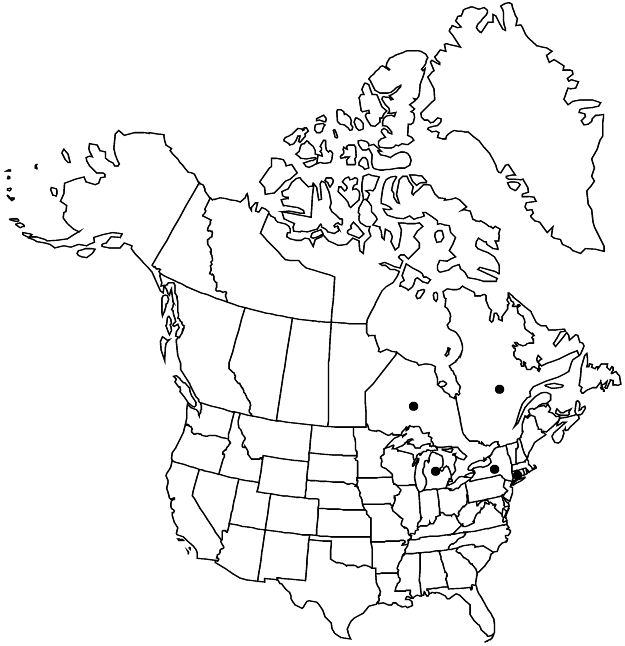Crataegus suborbiculata
Rhodora 3: 72. 1901.
Shrubs or trees, 80 dm. Stems: twigs: new growth reddish, 1-year old tan, 2-years old light gray; thorns on twigs straight, 2-years old blackish, usually shiny, ± slender, 2.5–4.5 cm. Leaves: petiole length 50–100% blade, eglandular or with 1–2(–3) glands; blade broadly elliptic or rhombic to suborbiculate, 4–6 cm, thin, base cuneate to broadly cuneate, lobes 3 or 4 per side, sinuses shallow, lobe apex acute, margins serrate, eglandular, veins 5 or 6 per side, apex acute to obtuse, surfaces glabrous, adaxial sparsely hairy young. Inflorescences 5–10-flowered; branches glabrous; bracteoles sometimes absent, margins glandular. Flowers 20–24 mm diam.; sepals narrowly triangular, 5–6 mm, margins subentire, abaxially glabrous; stamens 20, anthers cream, pink, or red, 0.7 mm; styles 4. Pomes pink mauve, ripening to orange-red or purplish, 10–14 mm diam., pruinose at first; sepals not on collar, spreading; pyrenes 3 or 4. 2n = 68.
Phenology: Flowering May–Jun; fruiting Sep–Oct.
Habitat: Woodland margins, brush
Elevation: 50–300 m
Distribution

Ont., Que., Conn., Mich., N.Y.
Discussion
Of conservation concern.
Crataegus suborbiculata is uncommon but is found in a number of locations in southern Ontario, and extends east to Quebec, New York, and Connecticut, and west to Michigan. Fruiting specimens, seemingly of this species but in poor condition, have been collected along the Skyline Drive of Virginia.
Very rare forms with slight inflorescence pilosity may occur and then Crataegus suborbiculata may look very much like some forms of C. florifera (ser. Anomalae), which is distinguished by its pyrenes. One large Ontario population is rather similar to C. compacta except that it is larger in all its parts and has proportionately slightly wider leaves. Very rare forms with narrower leaves (elliptic-rhombic) and small anthers may be referred to C. nitidula Sargent, known from southern Ontario, Michigan, Pennsylvania, and Wisconsin. Forms named C. umbratilis Sargent from Connecticut and Pennsylvania have slightly larger, more venous leaves with larger marginal teeth than the above and an elevated calyx in fruit. The poorly understood C. durobrivensis Sargent was suggested by E. J. Palmer (1952) to be a hybrid with C. pruinosa.
Selected References
None.